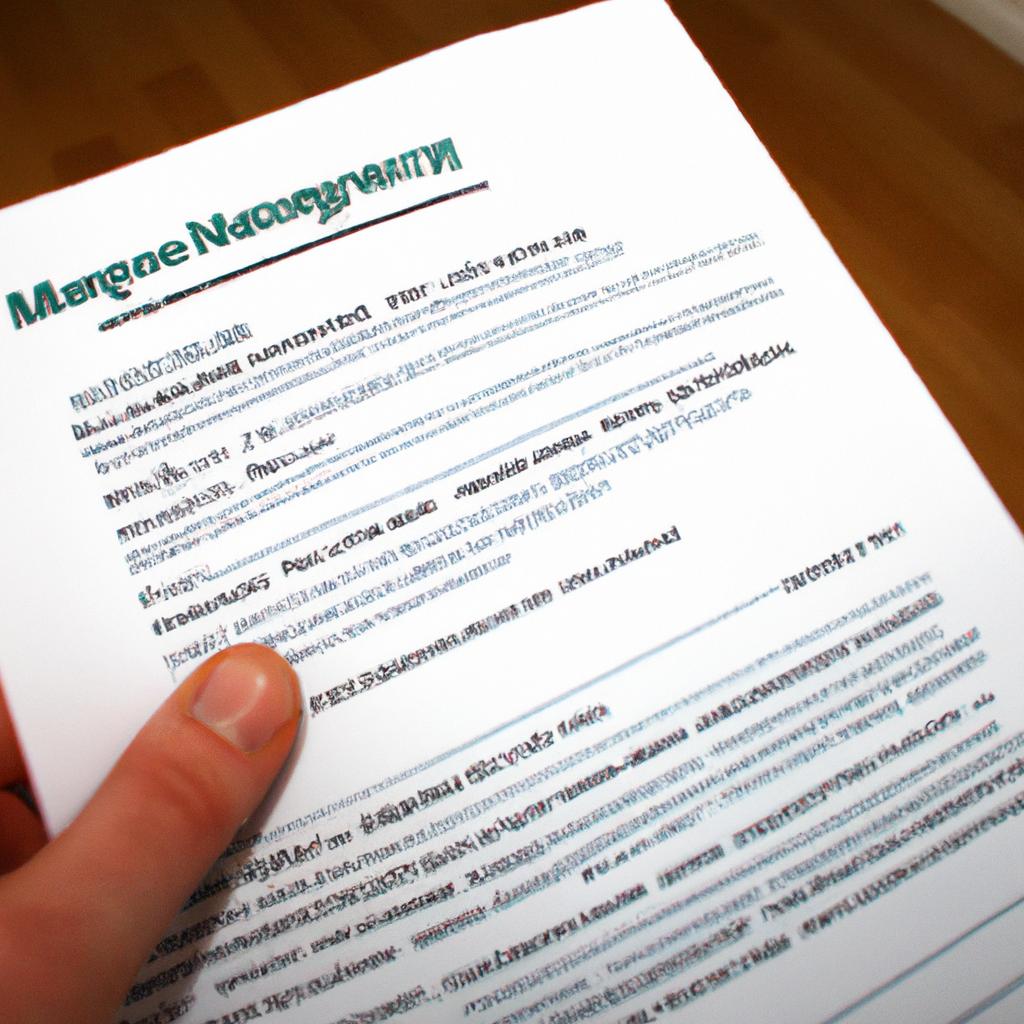In the realm of housing finance, there exists a unique and intriguing hybrid known as the balloon mortgage. This financial instrument combines features from both fixed-rate mortgages and adjustable-rate mortgages to provide homeowners with an alternative option for financing their homes. The concept behind the balloon mortgage involves making low monthly payments during an initial period, followed by a large payment (the “balloon”) at the end of the term. To illustrate its potential impact, consider the hypothetical case of Mr. Smith, who purchases a house using a balloon mortgage.
Mr. Smith, a middle-income individual seeking to purchase his first home, decides to explore various housing finance options. After careful consideration, he opts for a balloon mortgage due to its attractive initial interest rate and lower monthly payments compared to traditional fixed-rate mortgages. For the first five years of his loan term, Mr. Smith enjoys the benefits of reduced monthly payments that allow him to allocate more funds towards other expenses or savings goals. However, at the end of this initial period, Mr. Smith is faced with a significant lump sum payment that must be made in order to fully satisfy his outstanding debt on the property.
The example above highlights one aspect of balloon mortgages – their unique repayment structure that can pose challenges for borrowers at certain points in their loan term. While the low monthly payments during the initial period may be appealing, borrowers need to be prepared for the large balloon payment that awaits them at the end of this period. This can put financial strain on borrowers if they are unable to come up with the funds to make the final payment.
In Mr. Smith’s case, he would need to have a plan in place to address this large payment when it becomes due. He could potentially refinance his mortgage before the balloon payment is due, converting it into a traditional fixed-rate or adjustable-rate mortgage. Alternatively, he could sell the property and use the proceeds from the sale to pay off the remaining balance on his loan.
It’s important for borrowers considering a balloon mortgage to carefully evaluate their financial situation and future prospects. They should assess whether they will be able to afford the balloon payment or whether they have a clear strategy in place for refinancing or selling the property before that point.
Additionally, borrowers should consider any potential risks associated with balloon mortgages, such as changes in interest rates. If interest rates rise significantly during the loan term, refinancing options may become limited and borrowers may face higher monthly payments after the initial period ends.
In summary, while balloon mortgages offer lower initial monthly payments and potentially lower interest rates, borrowers should approach them with caution and fully understand their implications. It is advisable to consult with a financial advisor or mortgage professional before committing to a balloon mortgage to ensure it aligns with their long-term goals and financial capabilities.
What is a Balloon Mortgage?
A balloon mortgage is a type of hybrid housing finance that offers lower monthly payments initially, but requires the borrower to pay off the remaining balance in one lump sum at the end of a specified term. This unique structure can be advantageous for certain individuals and situations.
To better understand how a balloon mortgage works, let’s consider an example. Imagine John wants to purchase his dream home worth $500,000. However, he currently lacks sufficient funds for making sizable monthly payments required by traditional mortgages. In this scenario, John might opt for a balloon mortgage as it allows him to make smaller monthly installments over an agreed-upon period, typically 5 or 7 years.
Here are some key aspects to consider when thinking about a balloon mortgage:
- Lower Initial Payments: Initially, borrowers benefit from reduced monthly payments compared to fixed-rate mortgages.
- Limited Term: The repayment period for a balloon mortgage usually falls between 5 and 10 years.
- Balloon Payment: At the end of the term, borrowers must pay off the remaining loan balance all at once.
- Refinancing Options: Borrowers may have the flexibility to refinance their loans before reaching the final payment date.
By utilizing these bullet points and incorporating them into our discussion on balloon mortgages, we shed light on both practical considerations and potential emotional responses associated with this financing option.
| Advantages | Disadvantages | Considerations |
|---|---|---|
| Lower initial payments allow more affordable homeownership | Risk of being unable to afford the large lump-sum payment at maturity | Careful financial planning necessary |
| Shorter-term commitment provides flexibility for future financial changes | Potential difficulty in refinancing if property value decreases significantly | Evaluate long-term goals and stability |
| Ideal for those expecting increased income within a specific timeframe | Limited options available if interest rates rise dramatically during repayment period | Assess ability to handle financial uncertainties |
| Opportunity to invest savings or generate returns during the lower payment period | Difficulty in predicting future property values, potentially affecting refinancing options | Consider potential investment opportunities |
In summary, a balloon mortgage offers an alternative approach to financing homeownership by allowing for smaller monthly payments initially. However, it is essential to consider the unique repayment structure and associated risks before committing to this type of loan. In the subsequent section, we will explore how exactly a balloon mortgage functions without reliance on traditional step-by-step explanations.
Next, let us delve into understanding “How does a Balloon Mortgage work?”
How does a Balloon Mortgage work?
Transition from the previous section: Understanding what a balloon mortgage is provides a foundation for exploring how this unique type of housing finance works. Now, let’s delve deeper into the mechanics behind a balloon mortgage and its various components.
How does a Balloon Mortgage work?
To illustrate how a balloon mortgage functions, consider the following example:
Imagine you are purchasing your dream home worth $300,000. Instead of opting for a traditional fixed-rate or adjustable-rate mortgage, you decide to pursue a balloon mortgage. The terms of your loan stipulate that it will last for 30 years with an interest rate of 4%. However, unlike conventional mortgages, your monthly payments will only cover the interest during the initial five-year period. At the end of those five years, you’ll be required to pay off the remaining principal balance in full as one large “balloon payment.”
Key Features of a Balloon Mortgage:
When considering whether a balloon mortgage aligns with your financial goals and capabilities, it’s crucial to be aware of its distinctive features:
- Lower Monthly Payments: Since only interest is paid initially, borrowers benefit from lower monthly payments compared to fully amortizing mortgages.
- Risk of Refinancing: Due to the need for making a final lump sum payment at maturity, borrowers must plan ahead by either refinancing their loan or ensuring they have sufficient funds available.
- Maturity Date: A balloon mortgage has a specified term length (e.g., 5 or 7 years) before reaching maturity when the outstanding principal becomes due.
- Adjustable Rates: In some cases, balloon mortgages offer adjustable rates rather than fixed ones after the initial period.
| Feature | Description |
|---|---|
| Lower Monthly Payments | Initially paying only interest results in reduced monthly installments |
| Risk of Refinancing | Borrowers face the risk of needing to refinance their loan or prepare for a lump sum payment at maturity |
| Maturity Date | A specified term length before the outstanding principal becomes due |
| Adjustable Rates | In some cases, balloon mortgages offer adjustable rates after the initial period |
By understanding these key features, borrowers can make informed decisions about whether a balloon mortgage aligns with their unique financial circumstances and long-term goals.
Understanding these benefits will provide further insight into why individuals opt for this hybrid housing finance option in certain situations.
Advantages of a Balloon Mortgage
Transitioning smoothly from the previous section on how a balloon mortgage works, let’s explore the advantages that this type of housing finance can offer. To illustrate these benefits, consider the case study below:
Imagine John and Sarah, a newly married couple looking to purchase their first home in an area with rapidly appreciating property values. They have stable jobs and are confident about their future income growth. However, they currently have limited savings for a down payment.
Advantages of a Balloon Mortgage:
- Initial lower monthly payments: With a balloon mortgage, borrowers typically enjoy lower monthly payments at the beginning of the loan term compared to fixed-rate mortgages or even adjustable-rate mortgages (ARMs). This can be particularly beneficial for borrowers who anticipate an increase in their income over time or plan to sell the property before the balloon payment becomes due.
- Flexibility in financing options: Balloon mortgages provide flexibility when it comes to financing options. Borrowers can choose various terms for their loans, such as 5/25 (whereby they make relatively small payments for five years before paying off the remaining balance) or 7/23 (with seven years of smaller payments followed by full repayment). These options allow borrowers to align their mortgage terms more closely with their financial goals and specific circumstances.
- Potential cost savings: In certain situations, opting for a balloon mortgage may result in overall cost savings compared to other types of loans. For instance, if borrowers expect to move or refinance within the initial few years of homeownership, they could benefit from lower interest rates during that period.
- Lower initial monthly payments
- Flexible financing options
- Potential cost savings
Now let’s delve into these advantages further through an illustrative table highlighting some key aspects:
| Advantage | Description |
|---|---|
| Lower initial payments | Borrowers can enjoy lower monthly payments at the beginning of the loan term. |
| Flexible financing options | Balloon mortgages offer a range of terms, allowing borrowers to align their mortgage with their financial goals. |
| Potential cost savings | In certain situations, opting for a balloon mortgage may result in overall cost savings compared to other loans. |
As illustrated above, a balloon mortgage presents several advantages that can be appealing to specific individuals or families seeking homeownership under unique circumstances.
Transitioning smoothly into the subsequent section on “Disadvantages of a Balloon Mortgage,” it is essential to consider both sides of this housing finance option before making any decisions.
Disadvantages of a Balloon Mortgage
In the previous section, we explored the advantages of a balloon mortgage. Now, let’s delve into its disadvantages to gain a comprehensive understanding of this hybrid housing finance option.
One real-life example that illustrates the potential drawbacks of a balloon mortgage is as follows: Imagine Mr. and Mrs. Johnson purchasing their dream home with a five-year balloon mortgage. At first, they are attracted by the lower initial monthly payments compared to traditional fixed-rate mortgages. However, when the balloon payment becomes due at the end of the loan term, they find themselves in a financially tight situation because they didn’t adequately plan for it. This highlights one significant disadvantage – the need for careful financial planning and disciplined saving throughout the loan term.
When considering whether to opt for a balloon mortgage, it is essential to weigh both its advantages and disadvantages. Here are some key points to consider:
- Uncertainty regarding refinancing options: If interest rates rise significantly during your loan term, you may face challenges refinancing your balloon mortgage once it matures.
- Potential negative equity risk: If property values decline or remain stagnant over time, there is an increased risk of owing more on your home than it is worth when it comes time to refinance or sell.
- Limited flexibility in selling your property: With a balloon mortgage, selling your property before the maturity date can be difficult if you haven’t built enough equity or if market conditions aren’t favorable.
- Emotional stress associated with uncertainty: The prospect of facing a large lump sum payment at the end of the loan term can cause anxiety and stress among borrowers.
To better understand these disadvantages visually, here is a table summarizing them:
| Disadvantage | Explanation |
|---|---|
| Uncertain refinancing options | Rising interest rates during the loan term may limit your ability to refinance |
| Negative equity risk | Property value declines or stagnation can result in owing more on your home than it is worth |
| Limited flexibility in selling | Selling before the maturity date can be challenging if equity isn’t built or market conditions aren’t favorable |
| Emotional stress | The anticipation of a large lump sum payment at the end of the loan term can cause anxiety |
In conclusion, while balloon mortgages have their advantages, they come with inherent risks and considerations that borrowers must carefully evaluate.
Is a Balloon Mortgage suitable for you?
While a balloon mortgage can be an appealing option for some, it is important to consider its potential disadvantages. To illustrate these drawbacks, let’s consider the case of Mr. and Mrs. Johnson, who decided to take out a balloon mortgage on their dream home.
Initially attracted by the lower monthly payments during the fixed-rate period, the Johnsons soon realized that they were facing several challenges with their balloon mortgage. Firstly, as the maturity date approached, they found themselves under significant pressure to secure refinancing or sell their home in order to pay off the remaining balance. This placed them at risk of potentially losing their beloved property if market conditions were unfavorable or if financial circumstances changed unexpectedly.
Secondly, unlike traditional mortgages that allow homeowners to build equity gradually over time through regular principal payments, the Johnsons discovered that most of their monthly payments went towards interest rather than reducing the loan amount. As such, despite making timely payments for years, their overall debt remained largely unchanged until the final payment became due.
Lastly, even though balloon mortgages generally offer flexibility in terms of prepayment penalties and options for early repayment without penalty fees are often available after a certain period, these benefits did not outweigh the uncertainties associated with having a large lump sum payment looming ahead.
Considering these issues faced by individuals like Mr. and Mrs. Johnson when dealing with balloon mortgages, it is crucial to evaluate whether this type of financing aligns with your long-term goals and financial situation.
Disadvantages of a Balloon Mortgage:
- Potential risk of losing one’s home if unable to refinance or sell before maturity
- Limited opportunity for building equity due to predominantly interest-based payments
- Uncertainty regarding future ability to make a large lump-sum payment
| Risk | Impact |
|---|---|
| Market fluctuations | Decreased property value may hinder refinancing/selling |
| Changing financial circumstances | Difficulty meeting financial obligations for the final payment |
| Limited equity accumulation | Reduced net worth due to higher interest payments |
As we have seen, balloon mortgages carry significant disadvantages that may not be suitable for everyone.
[Transition sentence into subsequent section about “Alternatives to a Balloon Mortgage”] While it is important to consider all aspects of a balloon mortgage, exploring alternatives can help individuals make informed decisions when it comes to financing their homes.Alternatives to a Balloon Mortgage
Having evaluated whether a balloon mortgage is suitable for your individual financial situation, let us now explore some alternative options that may better align with your long-term housing finance goals.
As you consider different alternatives to a balloon mortgage, it can be helpful to examine real-life scenarios. Take, for instance, the case of Mr. and Mrs. Johnson who were contemplating purchasing their first home. After careful deliberation, they decided against a balloon mortgage due to its inherent risks and uncertainties. Instead, they explored other financing options that provided greater stability and predictability over the long term.
Here are several viable alternatives worth considering when seeking an alternative housing finance option:
- Fixed-Rate Mortgages: These mortgages offer the advantage of consistent interest rates throughout the loan term, providing borrowers with clear expectations of their monthly payments.
- Adjustable-Rate Mortgages (ARMs): ARMs allow borrowers to take advantage of lower initial interest rates compared to fixed-rate mortgages. However, keep in mind that these rates may fluctuate periodically based on market conditions.
- Government-Sponsored Programs: Various government-sponsored programs exist to support homeownership, such as loans offered by the Federal Housing Administration (FHA) or Veterans Affairs (VA). These programs often have more favorable terms and requirements than traditional mortgages.
- Renting-to-Own: This arrangement allows individuals to rent a property initially but also includes an option to purchase the property at a later date. It offers flexibility for those not ready or unable to commit fully to homeownership immediately.
To further assist in evaluating these alternatives, consider the following table comparing key features:
| Financing Option | Interest Rate | Monthly Payment |
|---|---|---|
| Fixed-Rate Mortgage | Consistent | Predictable |
| Adjustable-Rate | Initially Lower | May Fluctuate |
| Mortgage | ||
| Government-Sponsored | Varies, often more | Favorable terms and |
| Programs | favorable | requirements |
| Renting-to-Own | N/A (rent payments) | Potential future |
| homeownership opportunity |
By exploring these alternatives to a balloon mortgage, you can make an informed decision that best aligns with your housing finance goals. Remember to assess the pros and cons of each option in relation to your financial situation before committing to any particular path.
 SMI Loan
SMI Loan



